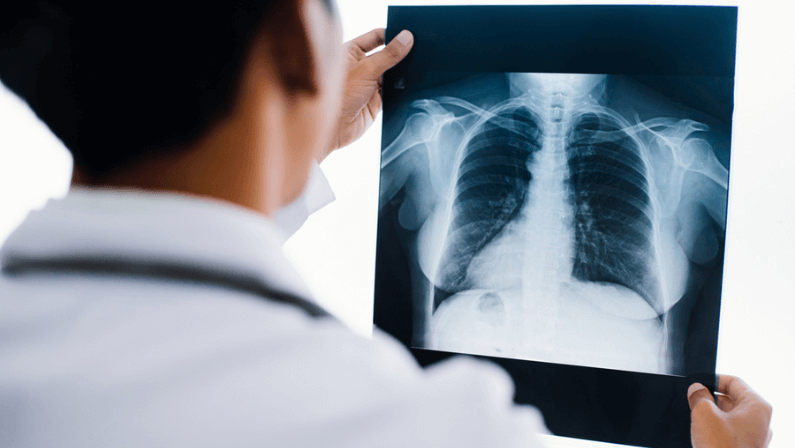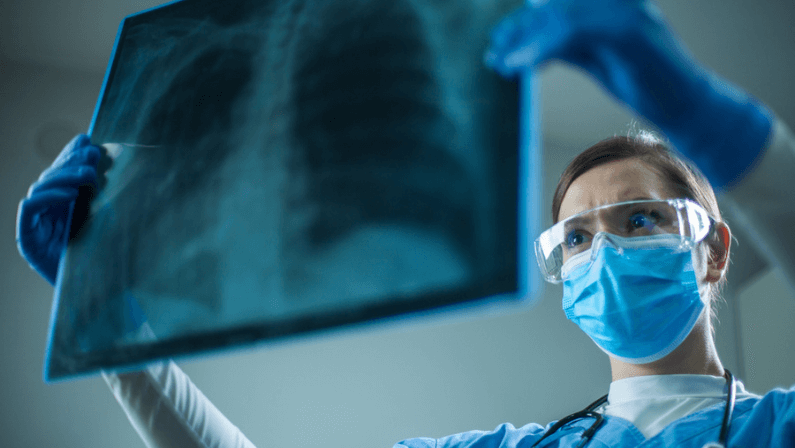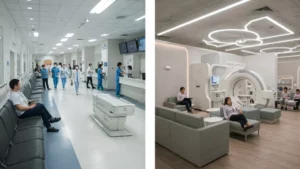Pneumonia, a common respiratory infection, can affect anyone, from infants to the elderly. It occurs when the air sacs in the lungs become inflamed and filled with fluid or pus, leading to symptoms such as cough, fever, and difficulty breathing. While clinical evaluation and history-taking play crucial roles in diagnosing pneumonia, chest X-rays serve as invaluable tools for confirming the diagnosis and assessing the severity of the condition.
What is pneumonia?
Pneumonia is an inflammatory condition of the lungs primarily caused by infectious agents, including bacteria, viruses, and fungi. The infection can spread through inhalation of airborne pathogens or aspiration of oral secretions into the lungs.
Common symptoms of pneumonia include cough, fever, chills, chest pain, and difficulty breathing. Individuals with weakened immune systems, chronic lung diseases, or underlying health conditions are at a higher risk of developing pneumonia. If left untreated, pneumonia can lead to complications such as pleural effusion, respiratory failure, or sepsis.
Can chest X-rays accurately diagnose pneumonia?

Yes, chest X-rays are an essential tool in diagnosing pneumonia. They can detect signs of pneumonia on chest X-rays or characteristic abnormalities, such as infiltrates and consolidations in the lungs, which are indicative of pneumonia.
However, in some cases, additional tests like blood cultures, sputum samples, or pathology testing might be required to confirm the diagnosis, particularly if the X-ray results are inconclusive.
The process of pathology testing has become more convenient with the availability of online options. If pneumonia is suspected, it’s crucial to consult a healthcare professional for a thorough evaluation.
The Role of X-rays in Diagnosing Pneumonia
Chest X-rays play a huge role in diagnosing pneumonia (X-ray of lung pneumonia) by providing evidence of lung abnormalities. They serve as invaluable tools in the armamentarium of healthcare providers for several reasons, including:
Visual Representation
Chest X-rays provide a visual representation of lung anatomy, enabling healthcare professionals to detect abnormalities associated with pneumonia.
Identification of Abnormalities
X-rays reveal infiltrates, consolidation, or opacities in the affected lung segments, indicating inflammatory changes and fluid accumulation.
Differentiation of Pneumonia Types
X-ray findings help differentiate between bacterial and viral pneumonia based on distinct patterns such as lobar consolidation or diffuse interstitial infiltrates.
Assessment of Severity
X-ray images assist in assessing the severity of pneumonia by evaluating the extent and distribution of lung abnormalities, guiding clinical management decisions.
Monitoring Treatment Response
Serial chest X-rays track changes in lung pathology over time, assessing the resolution of infiltrates and consolidation following antibiotic therapy.
Detection of Complications
X-ray findings may reveal complications such as pleural effusions, abscess formation, or pneumothorax, prompting timely intervention to prevent further morbidity and mortality.
Interpreting a Chest X-ray for Pneumonia

Understanding how pneumonia manifests on an X-ray is crucial for accurate diagnosis and effective treatment. A chest X-ray serves as a window into the lungs, allowing healthcare professionals to visualize any abnormalities indicative of pneumonia.
Normal Appearance in Healthy Individuals
What does a normal X-ray look like?
- Clear lung fields.
- Well-defined rib and diaphragm outlines.
Abnormal Findings in Pneumonia (X-ray of lungs with pneumonia)
What does an X-ray of pneumonia look like? The chest X-ray findings of pneumonia may appear as follows:
- Dense, patchy infiltrates or areas of opacity within the lung tissue.
- These infiltrates represent inflammatory changes and fluid accumulation.
Location of Abnormalities (Images of pneumonia on X-ray)
- Predominantly observed in the lower lobes of the lungs.
- Reflects the tendency of pneumonia to affect dependent lung regions.
Variations Based on Etiology
- Bacterial pneumonia: Often presents with lobar consolidation, indicating involvement of the entire lobe.
- Viral pneumonia: Characterized by diffuse interstitial infiltrates, appearing as fine, linear opacities scattered throughout the lung parenchyma.
What is aspiration pneumonia?

Aspiration pneumonia occurs when foreign material, such as food, saliva, or stomach contents, is inhaled into the lungs, leading to inflammation and infection. The appearance of aspiration pneumonia on a chest X-ray can vary depending on factors such as the volume and composition of aspirated material, as well as the severity of lung involvement.
A chest X-ray of aspiration pneumonia typically shows patchy infiltrates scattered throughout the lungs, often with areas of consolidation indicating inflammatory exudate accumulation. Segmental or lobar involvement may be observed, along with air bronchograms within consolidated areas. Pleural effusion may occur in severe cases.
How long does it take to get the results of a chest X-ray for pneumonia?
The turnaround time for receiving the results of a chest X-ray for pneumonia can vary depending on the facility and workload. In many cases, results are available within a few hours to a day. However, in urgent situations or busy healthcare settings, results may be expedited for quicker turnaround. It’s advisable to inquire about the expected timeline for receiving results from the healthcare provider or radiology center conducting the X-ray examination.
Patient Perspective: What to Know About X-Rays for Pneumonia
When it comes to undergoing medical procedures like X-rays for pneumonia diagnosis, understanding what to expect and how to prepare can ease anxieties and ensure a smoother experience. Here’s a closer look at the patient’s perspective on X-rays for pneumonia:
Painless and Non-invasive Procedure
X-rays are painless and non-invasive imaging tests commonly used in medical diagnostics. Patients simply need to position themselves appropriately while the X-ray machine captures images of their chest.
Minimal Radiation Exposure
While X-rays involve exposure to radiation, the amount used in diagnostic imaging is minimal and generally considered safe. Healthcare providers take precautions to minimize radiation exposure while ensuring optimal image quality for accurate diagnosis.
Preparation for the X-ray
Patients may be asked to remove any metal objects or jewelry that could interfere with the X-ray image. This ensures clear visualization of the chest area and prevents artifacts that may obscure diagnostic findings.
Communication with Healthcare Providers
It is crucial for patients to communicate any existing medical conditions, allergies, or concerns to the radiologist or healthcare provider before the X-ray examination. This information enables healthcare providers to tailor the procedure and ensure patient safety and comfort.
Considerations for Pregnancy
Pregnant individuals should inform their healthcare provider or radiologist before undergoing an X-ray examination. While radiation exposure from diagnostic X-rays is generally low and unlikely to cause harm to the fetus, precautions may be taken to minimize risk, such as shielding the abdomen with lead aprons.
Post-X-ray Follow-up
After the X-ray procedure, patients can expect to resume their normal activities without any significant downtime. Results of the X-ray will be reviewed by a radiologist or healthcare provider, who will communicate findings and any further steps required for diagnosis or treatment.
When to See a Doctor
Recognizing the signs and symptoms of pneumonia is crucial for timely medical intervention and optimal recovery. Knowing when to seek medical attention can help prevent complications and ensure prompt treatment, ultimately improving outcomes for individuals affected by this respiratory infection.
- Seek medical attention if you experience persistent symptoms of pneumonia, such as fever, cough, chest pain, or difficulty breathing.
- Individuals at higher risk, including the elderly, young children, and those with chronic health conditions, should consult a doctor promptly if they suspect pneumonia.
- Early diagnosis and treatment can prevent complications and facilitate a speedy recovery from pneumonia.
If you’re experiencing symptoms suggestive of pneumonia, such as a cough, fever, shortness of breath, or chest pain, it’s crucial to seek medical attention promptly. Early diagnosis and treatment are essential for a full recovery and to prevent complications. Many radiology centers, like One Step Diagnostic, can provide this vital diagnostic tool.
Taking Charge of Your Health: How To Diagnose Pneumonia
Chest X-rays play a vital role in diagnosing pneumonia by providing valuable insights into lung abnormalities. Understanding the signs of pneumonia on a chest X-ray, along with prompt medical evaluation, is crucial for timely diagnosis and appropriate management of this respiratory infection. By leveraging the power of X-ray imaging, healthcare professionals can effectively diagnose pneumonia and initiate timely interventions to improve patient outcomes.
One Step Diagnostic provides comprehensive diagnostic imaging services, including chest X-rays for pneumonia detection. With state-of-the-art equipment and experienced radiology professionals, patients can expect efficient and accurate assessments of their lung health. Contact them today!




